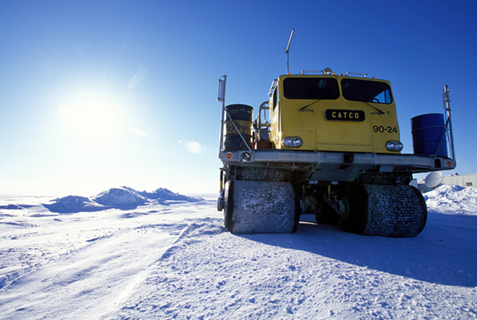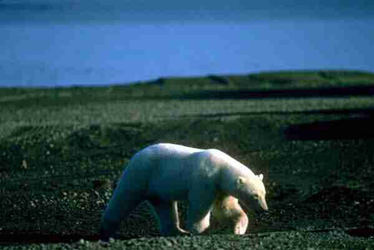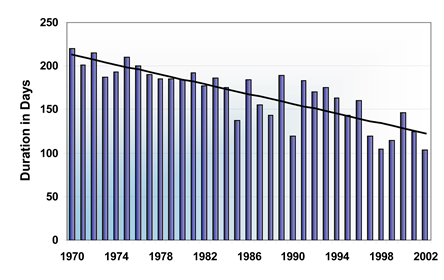Winter exploration seasons have become progressively shorter because of warming weather and changes in measuring techniques. As a result, the winter exploration season has been effectively cut in half since the early 1970s.
Exploration and development on the North Slope is dependent on transporting equipment across the tundra only when it is snowy and solid. Standards for depth of snow and ice were arbitrarily set in the 1970s, based on a minimum of six inches of snow and 1 foot of frozen ground. This originally established a 200-day winter season. However, over the past three decades, rising temperatures have cut the season in half to 100 days. Because of the North Slope's vast reserves and hydrocarbon potential, the length of the operations season is critical for industry, state and federal needs. DOE's goal is to assist the Alaska DNR by providing sound, unbiased scientific analysis. DNR officials want to revise the standards for tundra travel based on this scientific research. Funding by DOE, and cooperation between the State of Alaska and the petroleum industry, have allowed testing to determine the tundra's ability to withstand the impact of transport over a wider window of operating conditions.
Project Results
New standards for measuring ice and snow depth and ice road development allow for extension of the exploration and development season on the North Slope by over 30%. Alaska Department of Natural Resources (DNR) announced the opening of the Eastern Coastal area of the North Slope to oil and gas exploration on December 10, 2004, and the Western Coastal area on Dec. 16. The openings are the earliest since 1995 and 2-3 weeks earlier than last year. It is expected that the closing of the winter season also will be extended giving an overall season extension of 3-4 weeks.
Benefits
Lengthening a three-month exploration season by a month is a significant accomplishment. This increase in the exploration season, combined with the improvements in constructing ice roads, may allow companies to complete exploration wells within one season rather than two, with significant cost savings.
Project Summary
The DOE-UAF project goals called for it to develop an ecological model that would:
- Assess interactive effects on tundra travel.
- Predict tundra resistance to oil field disturbance.
- Set new standards for tundra travel.
- Allow exploration activities, including seismic surveys.
- Increase the period of time for these activities.
- Provide a better understanding of the tundra.
- Assess tundra resistance with regard to:
- Soil type.
- Vegetative cover.
- Snow depth and density.
- Depth of frozen ground.
The project researchers also developed a new tool to measure snow and permafrost depth.
The project developed an ecological model accounting for the interactive effects of snow conditions, soils, and vegetation to predict tundra resistance to oilfield disturbance in an effort to replace the current tundra travel standards. New standards for tundra travel will allow exploration activity, including seismic and exploration drilling, for an increased period of time.
The model will provide a better understanding of the tundra. Development of the ecological model entailed assessing tundra resistance to soil compaction and deformation including: soil type, vegetative cover, snow depth and density, and depth of frozen ground. The goal is to increase exploration and development activity concurrently with enhanced environmental protection.
The oil industry requires a minimum of 120 days of operation for effective exploration and development drilling. Decreased season length results in projects extending to up to eight years, creating delays, higher costs, and ultimately more damage to the tundra. Planned oil development on 8.8 million acres of Federal lands on the North Slope requires oil drilling equipment to cross state lands where access is dependent on the tundra travel standards.
The scientific evidence provided by this project should satisfy both industry and environmental groups that optimal protection of the tundra can be accomplished while providing a longer operational season on the North Slope.






